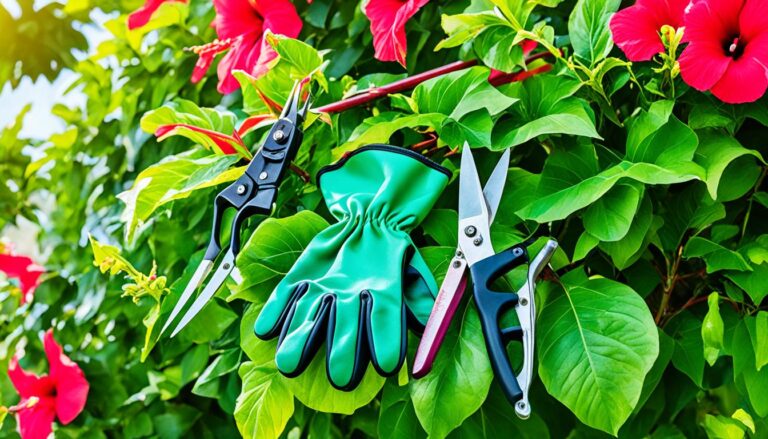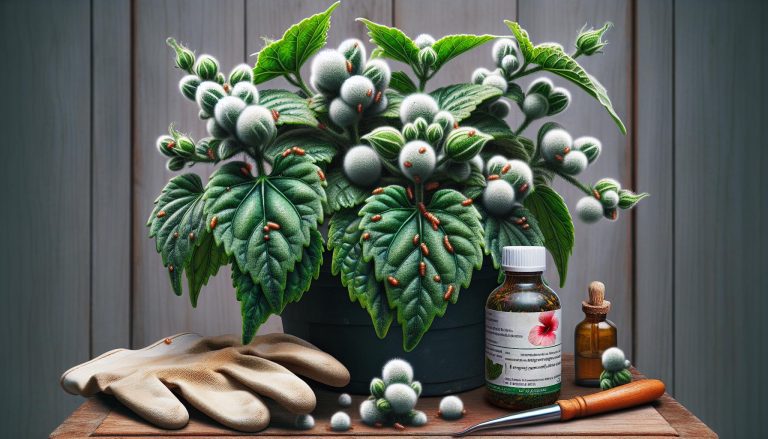How to Prune Hibiscus in Spring: Tips for Healthier Plants and More Blooms
As a passionate gardener, I’ve always been captivated by the vibrant blooms of hibiscus plants. These tropical beauties can transform any garden into a colorful paradise. But to keep them healthy and flourishing, proper pruning is essential – especially in spring.
Did you know that pruning hibiscus in spring can significantly boost its growth and flower production? It’s true! By removing dead or damaged branches and shaping the plant, you’ll encourage new growth and ensure a stunning display of flowers throughout the season. But how exactly should you go about pruning your hibiscus? What tools do you need, and what techniques work best? In this article, I’ll share my tried-and-true methods for spring hibiscus pruning, helping you achieve a lush, beautiful plant that’ll be the envy of your neighborhood.
Understanding Hibiscus Plants
Hibiscus plants are diverse and captivating, with unique growth patterns and blooming cycles. I’ll explore the different types of hibiscus and their specific characteristics to help you better understand these beautiful plants.
Types of Hibiscus
Hibiscus plants come in three main categories:
- Tropical hibiscus: Evergreen shrubs with glossy leaves and large, colorful flowers
- Hardy hibiscus: Perennial plants with heart-shaped leaves and dinner plate-sized blooms
- Rose of Sharon: Deciduous shrubs with smaller flowers and a tree-like growth habit
Each type has distinct care requirements and pruning needs. Tropical hibiscus, for example, is sensitive to cold and requires protection in colder climates, while hardy hibiscus can withstand freezing temperatures.
Growth Patterns and Blooming Cycles
Hibiscus plants exhibit varied growth patterns and blooming cycles:
- Tropical hibiscus:
- Grows rapidly in warm climates
- Blooms continuously throughout the growing season
- Flowers last only 1-2 days
- Hardy hibiscus:
- Dies back to the ground in winter
- Emerges late in spring
- Blooms from mid-summer to fall
- Rose of Sharon:
- Grows slowly into a multi-stemmed shrub or small tree
- Blooms late summer to fall
- Flowers last several days
Understanding these patterns is crucial for proper pruning timing and techniques. For instance, tropical hibiscus benefits from regular pruning to maintain shape and encourage new growth, while hardy hibiscus requires cutting back dead stems in early spring.
Benefits of Spring Pruning for Hibiscus
Spring pruning offers numerous advantages for hibiscus plants, promoting their overall health and appearance. It’s an essential practice that sets the stage for a vibrant growing season.
Promoting Healthy Growth
Spring pruning stimulates new growth in hibiscus plants by removing old, unproductive wood. It encourages the development of strong, healthy branches that can support more flowers. Pruning also improves air circulation and sunlight penetration throughout the plant, reducing the risk of fungal diseases. By removing crossing or rubbing branches, I create a more open structure that allows the plant to focus its energy on productive growth.
Enhancing Flower Production
Proper spring pruning significantly boosts flower production in hibiscus plants. By cutting back old growth, I encourage the formation of new buds, which ultimately lead to more flowers. Pruning also helps balance the plant’s energy distribution, directing resources towards flower development rather than maintaining excessive foliage. This results in a more abundant and impressive floral display throughout the blooming season. Additionally, removing spent blooms during pruning prevents the plant from expending energy on seed production, further promoting continuous flowering.
Tools Needed for Pruning Hibiscus
To prune hibiscus effectively, I’ll need the right tools and safety gear. Here’s what I use to ensure a clean, efficient pruning process for my hibiscus plants in spring.
Essential Pruning Equipment
For hibiscus pruning, I rely on bypass pruners, loppers, and pruning saws. Bypass pruners are perfect for cutting stems up to 3/4 inch in diameter, making clean cuts without crushing the plant tissue. For thicker branches, I use loppers, which can handle diameters up to 1 1/2 inches. When dealing with large, woody stems, a pruning saw is indispensable. I always disinfect my tools with rubbing alcohol before and after use to prevent disease spread.
Safety Gear
Safety is paramount when pruning hibiscus. I wear sturdy gardening gloves to protect my hands from thorns and potential skin irritants. Safety glasses shield my eyes from flying debris and sap. For taller hibiscus plants, I use a stable ladder and non-slip shoes to maintain balance. If I’m working with treated hibiscus or in areas with potential allergens, I also wear a dust mask to avoid inhaling harmful particles.
When to Prune Hibiscus in Spring
Spring pruning of hibiscus is crucial for optimal growth and blooming. The ideal timing varies depending on climate and the plant’s specific condition. Here’s what you need to know about when to prune your hibiscus in spring:
Ideal Timing for Different Climates
In warm climates (USDA zones 9-11), prune hibiscus in late winter or early spring, typically February to March. For cooler regions (zones 5-8), wait until late spring, around April to May, when the risk of frost has passed. In tropical climates, hibiscus can be pruned year-round, but early spring remains the optimal time for major pruning. Coastal areas benefit from pruning in mid-spring, as the moderate temperatures and increased humidity promote faster recovery.
Signs Your Hibiscus is Ready for Pruning
Look for these indicators to determine if your hibiscus is ready for spring pruning:
- New growth: Small green buds or leaves appearing on the stems
- Warmer temperatures: Consistent daytime temperatures above 50°F (10°C)
- End of dormancy: Plant showing signs of renewed activity after winter rest
- Increased sunlight: Longer days and stronger sunlight reaching the plant
- No frost risk: Weather forecasts indicating no more freezing temperatures
Always check the specific variety of your hibiscus, as tropical and hardy types may have slightly different pruning needs. Observe your plant’s growth patterns and adjust your pruning schedule accordingly for the best results.
Step-by-Step Guide to Pruning Hibiscus
Pruning hibiscus requires a systematic approach to ensure optimal growth and blooming. I’ll guide you through the essential steps to prune your hibiscus effectively, focusing on key areas that promote plant health and aesthetics.
Removing Dead or Damaged Branches
Start by identifying and removing dead or damaged branches. Use clean, sharp pruning shears to make clean cuts at a 45-degree angle, 1/4 inch above a leaf node. This technique prevents water from pooling on the cut surface and reduces the risk of disease. Remove any branches that are discolored, brittle, or show signs of pest infestation. Pruning these unhealthy parts redirects the plant’s energy to healthy growth and improves overall plant vigor.
Shaping the Plant
Shape your hibiscus to maintain its desired form and size. Cut back longer branches by 1/3 to 1/2 their length, making cuts just above outward-facing buds. This encourages outward growth and creates a fuller, more balanced appearance. For bushier growth, prune the tips of new shoots. To promote upward growth, remove lower branches. Always consider the natural growth habit of your specific hibiscus variety when shaping to enhance its inherent beauty.
Thinning Out Dense Areas
Thin out dense areas to improve air circulation and light penetration. Remove crossed or rubbing branches, selecting the weaker of the two. Eliminate any inward-growing branches to maintain an open center. Prune out approximately 1/3 of the oldest, thickest stems at the base to stimulate new growth from the bottom. This process, known as renewal pruning, revitalizes the plant and promotes stronger, more vigorous growth throughout the season.
Post-Pruning Care for Hibiscus
After pruning hibiscus, proper care is crucial for recovery and healthy growth. Here’s how to nurture your hibiscus post-pruning:
Watering and Fertilizing
Post-pruning, hibiscus plants need consistent moisture and nutrients. I water deeply once or twice a week, ensuring the soil is moist but not waterlogged. For fertilizing, I use a balanced, water-soluble fertilizer (10-10-10) every two weeks during the growing season. Organic options like compost tea or fish emulsion work well too. I avoid over-fertilizing, which can lead to excessive foliage growth at the expense of flowers.
Monitoring for New Growth
I closely observe my hibiscus for signs of new growth after pruning. New buds typically appear within 2-3 weeks. If I notice slow growth or yellowing leaves, I adjust watering or fertilizing accordingly. I also watch for pests like aphids or spider mites, which can attack vulnerable new growth. If I spot any issues, I address them promptly with appropriate treatments to ensure healthy development.
Common Mistakes to Avoid When Pruning Hibiscus
Pruning hibiscus requires care and attention to detail. By avoiding these common mistakes, you’ll ensure your hibiscus thrives after pruning.
Over-Pruning
Over-pruning is a frequent error that can severely damage hibiscus plants. I’ve seen gardeners remove more than 1/3 of the plant’s growth, which stresses the hibiscus and reduces its ability to produce flowers. To avoid this, I limit pruning to no more than 25-30% of the plant’s total growth. This approach maintains enough foliage for photosynthesis and energy production. When pruning, I focus on removing dead, diseased, or crossing branches first, then shape the plant as needed without excessive cutting.
Incorrect Cutting Techniques
Using improper cutting techniques can lead to damage and disease in hibiscus plants. I always make clean cuts at a 45-degree angle, about 1/4 inch above a leaf node or bud. This angle prevents water from pooling on the cut surface, reducing the risk of fungal infections. I use sharp, clean pruning shears to make precise cuts without crushing or tearing the branches. Dull or dirty tools can introduce pathogens and create jagged wounds that heal slowly. After each cut, I disinfect my tools with rubbing alcohol to prevent the spread of diseases between plants.
Conclusion
Pruning hibiscus in spring is a crucial task for maintaining healthy vibrant plants. By following the guidelines I’ve outlined you’ll be well-equipped to tackle this important gardening task. Remember to prune at the right time use proper techniques and avoid common mistakes. With a little care and attention your hibiscus will reward you with lush foliage and abundant blooms throughout the growing season. Happy pruning and enjoy the beautiful results of your efforts!







